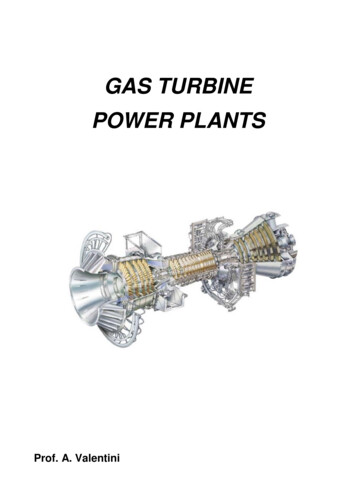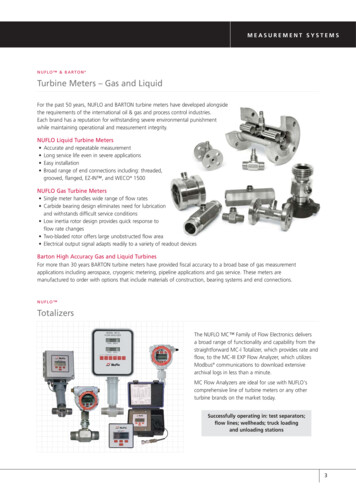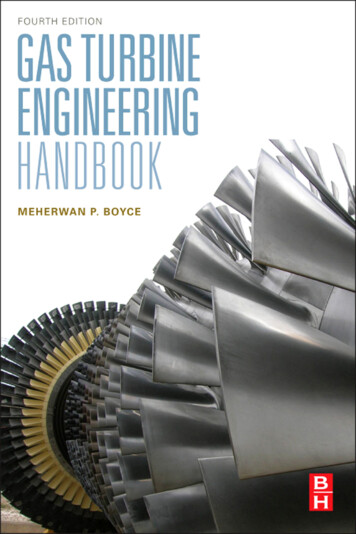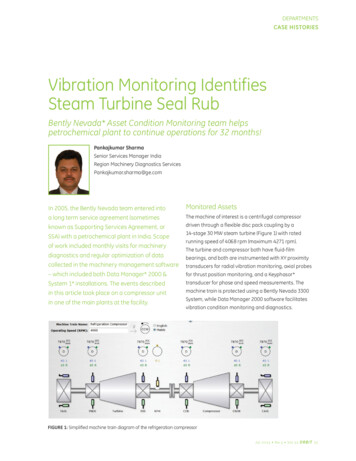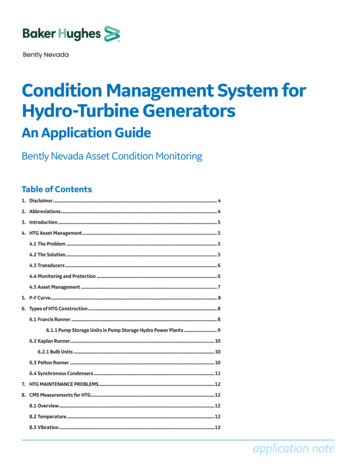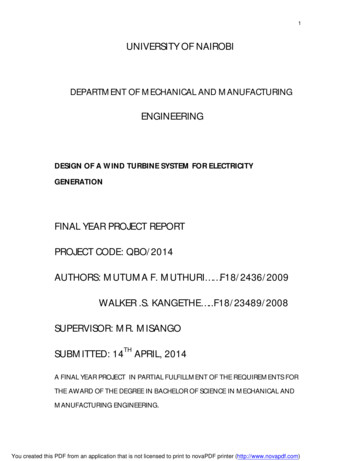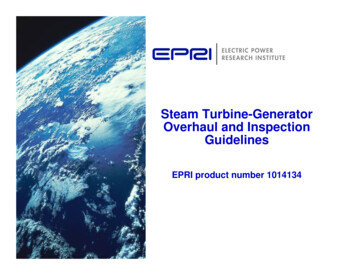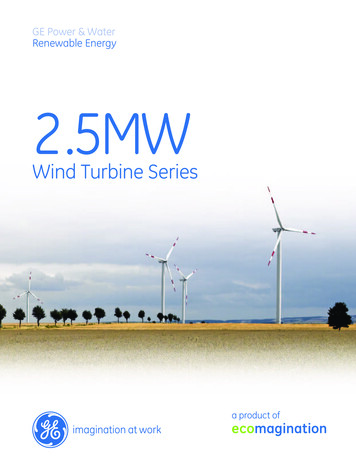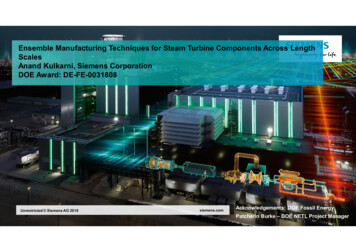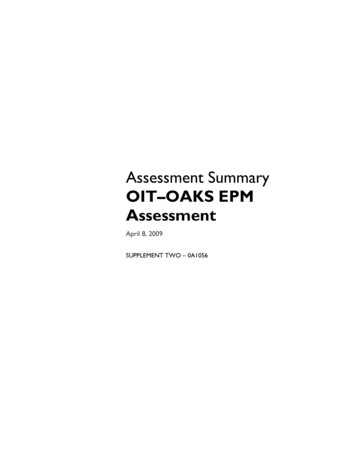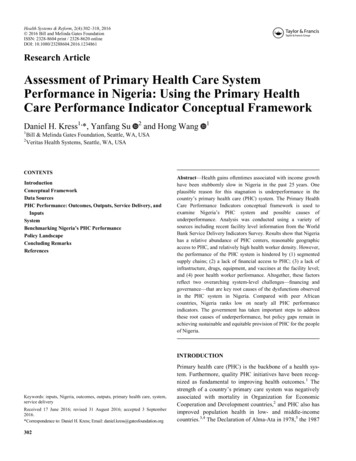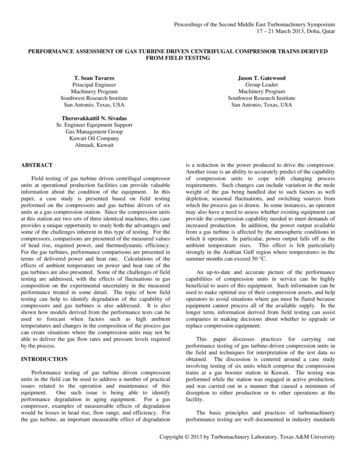
Transcription
Proceedings of the Second Middle East Turbomachinery Symposium17 – 21 March 2013, Doha, QatarPERFORMANCE ASSESSMENT OF GAS TURBINE DRIVEN CENTRIFUGAL COMPRESSOR TRAINS DERIVEDFROM FIELD TESTINGJason T. GatewoodGroup LeaderMachinery ProgramSouthwest Research InstituteSan Antonio, Texas, USAT. Sean TavaresPrincipal EngineerMachinery ProgramSouthwest Research InstituteSan Antonio, Texas, USATheruvakkattil N. SivadasSr. Engineer Equipment SupportGas Management GroupKuwait Oil CompanyAhmadi, KuwaitABSTRACTField testing of gas turbine driven centrifugal compressorunits at operational production facilities can provide valuableinformation about the condition of the equipment. In thispaper, a case study is presented based on field testingperformed on the compressors and gas turbine drivers of sixunits at a gas compression station. Since the compression unitsat this station are two sets of three identical machines, this caseprovides a unique opportunity to study both the advantages andsome of the challenges inherent in this type of testing. For thecompressors, comparisons are presented of the measured valuesof head rise, required power, and thermodynamic efficiency.For the gas turbines, performance comparisons are presented interms of delivered power and heat rate. Calculations of theeffects of ambient temperature on power and heat rate of thegas turbines are also presented. Some of the challenges of fieldtesting are addressed, with the effects of fluctuations in gascomposition on the experimental uncertainty in the measuredperformance treated in some detail. The topic of how fieldtesting can help to identify degradation of the capability ofcompressors and gas turbines is also addressed. It is alsoshown how models derived from the performance tests can beused to forecast when factors such as high ambienttemperatures and changes in the composition of the process gascan create situations where the compression units may not beable to deliver the gas flow rates and pressure levels requiredby the process.INTRODUCTIONPerformance testing of gas turbine driven compressionunits in the field can be used to address a number of practicalissues related to the operation and maintenance of thisequipment.One such issue is being able to identifyperformance degradation in aging equipment. For a gascompressor, examples of measureable effects of degradationwould be losses in head rise, flow range, and efficiency. Forthe gas turbine, an important measurable effect of degradationis a reduction in the power produced to drive the compressor.Another issue is an ability to accurately predict of the capabilityof compression units to cope with changing processrequirements. Such changes can include variation in the moleweight of the gas being handled due to such factors as welldepletion, seasonal fluctuations, and switching sources fromwhich the process gas is drawn. In some instances, an operatormay also have a need to assess whether existing equipment canprovide the compression capability needed to meet demands ofincreased production. In addition, the power output availablefrom a gas turbine is affected by the atmospheric conditions inwhich it operates. In particular, power output falls off as theambient temperature rises. This effect is felt particularlystrongly in the Arabian Gulf region where temperatures in thesummer months can exceed 50 C.An up-to-date and accurate picture of the performancecapabilities of compression units in service can be highlybeneficial to users of this equipment. Such information can beused to make optimal use of their compression assets, and helpoperators to avoid situations where gas must be flared becauseequipment cannot process all of the available supply. In thelonger term, information derived from field testing can assistcompanies in making decisions about whether to upgrade orreplace compression equipment.This paper discusses practices for carrying outperformance testing of gas turbine-driven compression units inthe field and techniques for interpretation of the test data soobtained. The discussion is centered around a case studyinvolving testing of six units which comprise the compressiontrains at a gas booster station in Kuwait. The testing wasperformed while the station was engaged in active production,and was carried out in a manner that caused a minimum ofdisruption to either production or to other operations at thefacility.The basic principles and practices of turbomachineryperformance testing are well documented in industry standardsCopyright 2013 by Turbomachinery Laboratory, Texas A&M University
such as ASME PTC-10 (1997) and ASME PTC-22 (2005).Guidelines and technical papers focused specifically onperforming such tests in the field include those by Brun &Nored (2006) and Brun & Kurz (2001). The testing describedin this paper was carried out in accordance with therecommendations of these publications to the extent possible.In the interpretation of the experimental data, establishedprinciples of turbomachinery performance and dynamicsimilitude were also employed. These principles can be foundin the literature in such works at those by Shephard (1956),Dixon (1998), and Aungier (2000).However, there are sometimes practical considerations atoperating production facilities that require compromises to bemade during the test program. In addition, there are somesources of uncertainty encountered that are not found under themore highly controlled conditions of the research laboratory orthe factory acceptance test. This paper addresses some of thesecompromises and uncertainties and demonstrates that in spite ofthem, performance characteristics can be measured in the fieldthat will be highly valuable to the owners and operators of gasturbine driven compression equipment.EQUIPMENT TESTEDThe equipment tested consisted of six gas turbine drivennatural gas compression units located at a booster stationbelonging to the Kuwait Oil Company. The arrangement ofequipment at the site is shown schematically in Figure 1. Thecompression equipment is arranged in three compression trains.Each train consists of a Low Pressure (LP) Compressor and aHigh Pressure (HP) Compressor, each having its own gasturbine driver. The gas compressed by the LP units is suppliedfrom a gas network. The gas compressed by the HP unitsconsists of gas from the LP compressors and also gas fromother streams which are already at pressures high enough to befed directly to the HP units. In terms of mass flow, asubstantially larger amount of gas is processed by the HP unitsthan the LP units. The compositions, and hence the moleweights, of the LP gas and the HP gas fluctuates somewhatduring normal operation. The gas turbines are fueled by naturalgas fed from a separate set of lines. The composition of thefuel gas also fluctuates.Figure 1. Arrangement of Compression Units at the GasBooster Station Where Testing was PerformedTESTING PROCEDURES & INSTRUMENTATIONThe procedures employed in the test program were guidedby published industry standards for turbomachinery testing.These included the relevant ASME compressor and gas turbinetest codes (ASME PTC-10 (1997) and ASME PTC-22 (2005)),and the GMRC guideline on performance testing in the field(Brun & Nored (2006)). During the test program describedhere, the relevant parts of these standards were adhered to asclosely as practical.In accordance with the project test plan, performancemeasurements were taken on each unit at five test points. Forfour of these points, the compressor was run at 100 percent ofits normal operating speed and the load on the compressor wasvaried in order to produce different operating conditions. Theprimary control used for adjusting the load was the compressorrecycle valve. The purpose of the fifth test point was tomeasure the maximum power capability of the gas turbine. Forthis test point, the compressor speed was increased to themaximum allowable value. Then, the compressor load wasincreased in an attempt to reach a condition requiring themaximum gas turbine power. The maximum power conditionwas indicated by the turbine exhaust gas temperature attainingits maximum allowable value. The maximum power conditionwas achieved for all three of the LP drivers. For the HP unitshowever, constraints in the system that did not involve thecompression units themselves prevented the maximum powercondition from being reached.Specifically, maximumallowable values of pressures and velocities in componentsdownstream of the compressor were reached while there wasstill some exhaust gas temperature margin remaining.Each time the operating condition was changed, time wasallowed for the pressures and temperatures to stabilize. Thisstabilization period is particularly important for temperature, assome time is required for heat transfer to occur that brings suchitems as thermowells and compressor casings to the sametemperature as the flowing gas. Once equilibrium was reached,readings were then taken using the data acquisition system.The testing standards referenced in this paper generallyrecommend taking four or more readings at each operatingcondition, spaced at intervals of at least 10 minutes. Adherenceto this recommendation means that an equilibrium conditionmust be held for at least 30 minutes. During these tests, theinterval between readings was generally shortened toapproximately seven minutes, allowing four readings to betaken in about 20 minutes. This was done for two reasons.Firstly, due to operational considerations at the compressorstation, it was often not possible to hold the unit under test at anoperating point for a longer period. This was particularly truefor operating conditions requiring a large amount of gas to bediverted to the unit under test.Secondly, the shortermeasurement time allowed test activities to be completed onone unit per working day. This modification of the testprocedure was felt to be a reasonable compromise betweenmaximum accuracy and practicality given the overall goals ofthis particular test program.Copyright 2013 by Turbomachinery Laboratory, Texas A&M University
InstrumentationThe schematic placement of measuring instrumentation onthe driven compressors and gas turbines is shown in Figure 2and Figure 3. Calibrated laboratory grade transducers wereused for measuring the temperatures and pressures required toobtain machine performance. The temperature transducersused were of the Resistance Temperature Detector (RTD) type.For making temperature measurements on the process gas andthe fuel gas, these were placed in available thermowells locatedat appropriate locations on the piping. Gas turbine air inlettemperature was also measured using an RTD; this was placedclose to the inlet filter in an area shaded from the sun.Fuel and process gas pressures were measured withpiezoelectric style transducers. Sensitive differential pressuregauges were used to measure the pressure differences across theorifice plates used in making flow measurements. Pressuretransducers were connected in parallel with those that are partof the permanently installed instrumentation. A hand heldweather station was employed to monitor barometric pressureand humidity throughout the tests.The temperature and pressure data was collected using acustom-built automated data acquisition system. This data wasstored on a laptop computer for later post processing. Otherunit operating parameters which were necessary for calculatingperformance were collected from the unit monitoring andcontrol systems. This included such items as compressorrotating speed and turbine exhaust temperature.Figure 3. Schematic of placement of test instrumentationon the gas turbine driver. (Excerpted from Brun & Nored,2006)Gas PropertiesThermodynamic properties of the process gas and the fuelgas are essential for the data reduction process. These arerequired for calculating the parameters describing compressorperformance, including head rise, power input, and efficiency.Gas properties are also required for calculating gas flow ratesfrom the pressure and temperature measurements taken on theflow meters. In addition, the lower heating value of the gas(LHV) is required in order to determine how much fuel energyis being supplied to the engine per unit time.Gas properties were obtained by taking samples of bothprocess gas and fuel gas and having the compositions of thesamples analyzed in a laboratory. The lab analysis provided themolecular composition of the gas and also the LHV. Duringthe data reduction process, the gas compositions were input intoa thermodynamic properties software package in order tocalculate the state point variables needed for makingperformance calculations.Figure 2. Schematic of Placement of Test Instrumentationon the Driven Compressor. (Excerpted from Brun & Nored,2006)Two samples each of process gas and fuel gas were takenduring the testing of each of the six units. The collection of thesamples occurred close to the beginning and end of the testperiod on each unit. This sampling interval resulted in 24samples being collected and analyzed during the test program.While it was recognized that fluctuations in gas compositioncould occur in much shorter time intervals, the number ofsamples taken was the maximum that it was consideredpractical to analyze for this program. It is perhaps possible thata portable gas chromatograph could be employed to analyze thecomposition much more frequently in future testing if moreprecise knowledge of gas composition is deemed necessary.RESULTS AND DISCUSSIONCompressor PerformanceThe data taken on the compressors was reduced to the formof non-dimensional coefficients. Expressing the results in thisform allows performance to be compared on a common basis,compensating for small variations of such quantities as inletpressure and temperature, gas composition, and rotating speed.Copyright 2013 by Turbomachinery Laboratory, Texas A&M University
5), most of the individual measurements fall within about
These included the relevant ASME compressor and gas turbine test codes (ASME PTC-10 (1997) and ASME PTC-22 (2005)), and the GMRC guideline on performance testing in the field (Brun & Nored (2006)). During the test program described here, the relevant parts of these standards were adhered to as closely as practical. In accordance with the project test plan, performance measurements were
